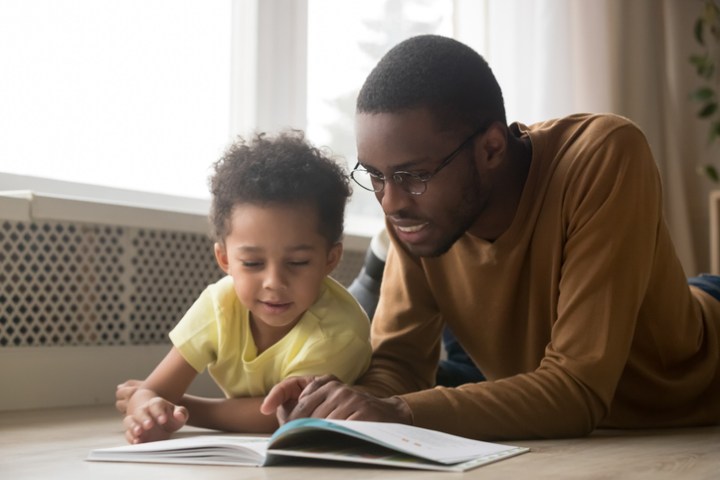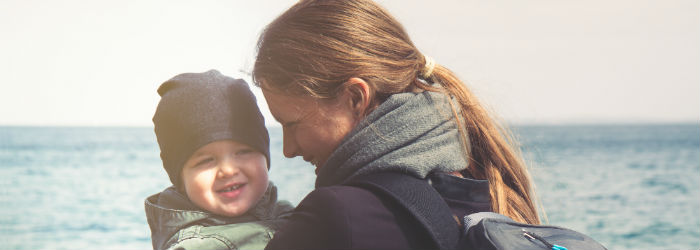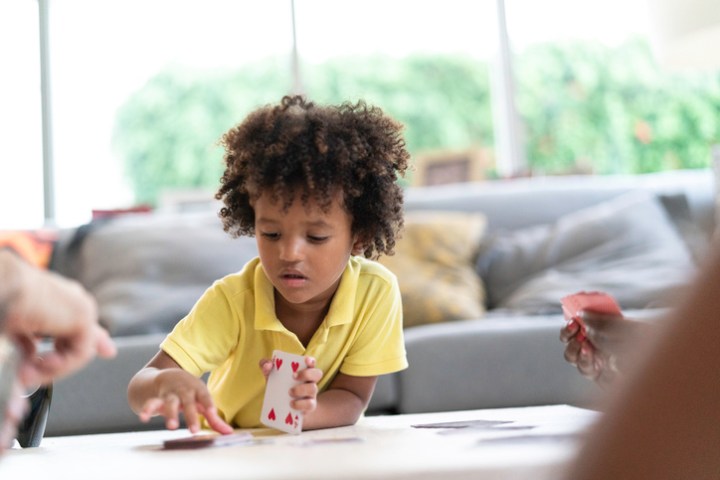The Power of Reading Aloud

A miracle occurs when one person reads to another, when words on a page are transformed into dynamic quests that move the heart, brain and imagination. Grounded in neuroscience and behavioural research, The Enchanted Hour explains the cognitive and social-emotional benefits that await children who are read to, not least engaging their minds in complex narratives, fostering imagination and kindling a lifelong appreciation of language stories and pictures.
“We almost never take this out because it is really fragile,” said Christine Nelson, a curator at the Morgan Library in New York. I was sitting across from her, in her office. She drew out a small navy-blue case and opened the lid. Inside, its glossy red leather binding embossed with gold, was the earliest surviving volume of the fairy tales of Charles Perrault. This beautiful object had been created in 1695 as a gift for the teenage niece of Louis the Fourteenth, a girl known as “Mademoiselle.”
Nelson opened to the frontispiece, revealing a charming little painting. A plain-faced woman in a linen coif and rustic dress sits before a fire, holding a spindle of wool. She seems to be telling a story to three young people in elegant clothes, one of whom leans forward, touching the storyteller’s knees in her eagerness. Curled up by the fire, a plump little cat listens, too. On the wooden door behind the spindle holder, a sign reads: “Contes de Ma Mere l’Oye.”
Tales of My Mother Goose! More than three centuries ago, a careful hand (possibly Perrault’s son, Pierre) had dipped a pen in ink and in beautiful cursive committed the world’s first known collection of fairy tales to this folio. Now the pages were fragile, crisp, and speckled with age spots.
There I was, sitting in a modern office building, with trucks and cars rumbling up nearby Madison Avenue, and for a fraction of a second the book before me seemed to become a portal, like a wardrobe into Narnia or a portkey at Hogwarts, that could fling me into the past. I had the fleeting idea that if I were to touch the page, I might be flashed back to a place of silks and mirrors and a laughing girl, and that if I were to squint or tip my head at the right angle, I might go deeper still, through the story and out the other side, into the hazy Indo-European folkways where the stories began. It was the impression of a moment, and it was whimsical, I know, but the tales that Perrault collected have such broad cultural resonance today that I felt giddy to be so close to the first Mother Goose.
Charles Perrault is credited with creating the literary tradition of the fairy tale, but of course the stories he told weren’t his. They had come from deep in the trackless past and were, by word of mouth, on their way into the future when he plucked them from the air and wrote them down. He and other collectors and folklorists over the centuries and across the world—enterprising individuals such as Marie-Catherine d’Aulnoy, Wilhelm and Jacob Grimm, Andrew Lang, Moltke Moe, Lafcadio Hearn, Charles Chesnutt, W. E. B. Du Bois, and many others—have preserved vast libraries derived from “the golden net-work of oral tradition” that might otherwise have been lost. Without their efforts, we would have inherited nothing like the richness of story, song, and legend available to us in the digital age.
I was thinking about this as Christine Nelson turned the page so that we could see Perrault’s version of “Le Petit Chaperon rouge”—Little Red Riding Hood, a tale so old that scholars have traced some of its elements to classical Greece and the myth of the child-swallowing Titan, Cronos. According to Bruno Bettelheim, the story has been told in France in one form or another since at least the eleventh century; he mentions a tale from that period, recorded in Latin, that tells of a little girl wearing a red cover, or cap, who’s found in the company of wolves.
In the Morgan Library’s edition of Perrault, the story of Little Red Riding Hood begins with another perfect little gemlike painting. In this one, a woman reclining in bed has raised herself up and seems almost to be greeting a large dog that has bounded up. The animal’s front paws are resting on the bed’s crimson coverlet. His hindquarters are hidden beneath its golden canopy. He is no dog, of course, but a wicked wolf: the artist has captured the moment of the grandmother’s destruction.
Underneath the picture, delicate French cursive writing tells the celebrated story. Just near the end, the scribe has inked an asterisk next to the famous lines of dialogue: “What big teeth you have!” and “The better to eat you with.” Tiny handwriting in the margin instructs the reader: “On prononce ces mots d’une voix forte pour faire peur a l’enfant comme si le loup l’alloit manger” (These words should be said in a loud voice to make the child afraid that the wolf will eat him). We know from this that Perrault didn’t create this exquisite collection for private enjoyment. He expected Mademoiselle to read the stories out loud.
***
“If you want your children to be intelligent, read them fairytales. If you want them to be more intelligent, read them more fairytales,” Albert Einstein advised. I don’t know if the great theoretical physicist really made that remark, and I cannot promise that reading fairy tales to a child will tweak his IQ, but there is no doubt that these weird dramas of risk, terror, loyalty, and reward agitate the blood and captivate the heart. To C. S. Lewis, time spent in what he called “fairyland” arouses in a child “a longing for he knows not what. It stirs and troubles him (to his lifelong enrichment) with the dim sense of something beyond his actual reach and, far from dulling or emptying the actual world, gives it a new dimension of depth. He does not despise real woods because he has read of enchanted woods: The reading makes all real woods a little enchanted.”
The reading does something else, too. It situates children in a cultural sense, equipping them to understand references to fairy tales and other classic stories that they will find all around them. When we read Hansel and Gretel or The Fisherman and His Wife or Puss in Boots, we’re at once transporting children with our voices and grounding them in foundational texts. For this reason, the time we spend reading to them can amount to a second education, one that helps children “acquire a sense of horizons,” in the phrase of linguist John McWhorter. What we give them is not schooling qua schooling, but an introduction to art and literature by means so calm and seamless that they may not notice it’s happening.
We can furnish their minds with eccentric oddments, beautiful images, and useful bits of general knowledge. We can introduce them to a world of peculiar and renowned characters: to Ali Baba and the Forty Thieves, to Custard the Dragon, to Corduroy, Strega Nona, and the Farmer in the Dell; to the Sheriff of Nottingham and the Velveteen Rabbit; to Baba Yaga and her house on chicken legs; to the boy who cried wolf, to Apollo and Artemis, to Daedalus and Icarus; to Coraline, Despereaux, the Runaway Bunny, and the tricksters Loki and Anansi and the Cat in the Hat.
We can give them what, in truth, is already theirs. The books and artwork of the world are, after all, the inherited property of every child. They are the natural estate of every boy or girl from the moment that he or she draws breath. Nursery rhymes, fairy tales, legends, myths, poetry, paintings, sculptures, the great body of classic literature, the bounty of new and forthcoming literature, whether for children or adults—all these things belong to the young and ignorant just as much as they do to the old and erudite. When the Dominican-born writer Junot Díaz was a boy, his elementary-school librarian in the United States showed him around the stacks and told him, he said years later, that “all the books on the shelves were mine.” It was a galvanizing moment that he never forgot. It is a message that every child needs to hear.
Owning something and taking possession of it are two different things, of course. A child may have as much right to Beowulf as the scholar who devotes his life to the study of Old English. Yet unless the child meets the hero Beowulf and the monster Grendel, and Grendel’s gruesome mother, he cannot be said to have taken possession of the property that’s his. Let that child’s mother read Beowulf in translation at bedtime (if she dares—it’s pretty gory), and the child’s custody is complete. The characters and scenes and language of the book will become part of his interior landscape. The book’s mystical qualities will add sublimity to his experience of life.
The more stories children hear, and the more varied and substantial those tales, the greater the confidence of their cultural ownership. They will recognize allusions that other children may miss. A girl who has heard the stories of Aesop or Jean de la Fontaine will have a clear idea of what is meant by “sour grapes” and will know why people compare the industriousness of ants and grasshoppers. A boy who’s heard a parent read The Odyssey has a more complete idea of what constitutes a “siren song” than his friend who thinks it must have something to do with an alarm going off.
The narratives of the past have helped to frame the consciousness and language of the present, and it’s a gift to children to help them recognize as much as they can. The milk of human kindness, the prick of the spindle, the wolf in sheep’s clothing, the wine-dark sea: all are expressions of a vast cultural treasury.
—
This article is extracted from Meghan Cox Gurdon’s The Enchanted Hour: The Miraculous Power of Reading Aloud in the Age of Distraction.








